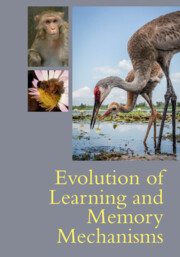Book contents
- Evolution of Learning and Memory Mechanisms
- Evolution of Learning and Memory Mechanisms
- Copyright page
- Contents
- Figures
- Tables
- Contributors
- Preface
- Introduction
- Part I Evolution of Learning Processes
- 1 Learning and Memory in the Nematode Caenorhabditis elegans
- 2 Adaptive Evolution of Learning and Memory in a Model Lineage
- 3 Learning in Insects: Perspectives and Possibilities
- 4 Experimental Evolution and Mechanisms for Prepared Learning
- 5 Evolutionary Processes Shaping Learning Ability in Insects
- 6 Brain and Spatial Cognition in Amphibians
- 7 Pavlovian Conditioning, Survival, and Reproductive Success
- 8 Compensatory Responses to Wildlife Control
- 9 Relational Memory Functions of the Hippocampal Pallium in Teleost Fish
- 10 Mechanisms Underlying Absolute and Relative Reward Value in Vertebrates
- 11 The Optimality of “Suboptimal” Choice
- 12 A Behavior Systems Framework
- 13 Dissociable Learning Processes
- 14 Social Learning Strategies
- 15 How Learning Affects Evolution
- Part II Evolution of Memory Processes
- Index
- References
8 - Compensatory Responses to Wildlife Control
Theoretical Considerations and Empirical Findings from the Invasive Common Myna
from Part I - Evolution of Learning Processes
Published online by Cambridge University Press: 26 May 2022
- Evolution of Learning and Memory Mechanisms
- Evolution of Learning and Memory Mechanisms
- Copyright page
- Contents
- Figures
- Tables
- Contributors
- Preface
- Introduction
- Part I Evolution of Learning Processes
- 1 Learning and Memory in the Nematode Caenorhabditis elegans
- 2 Adaptive Evolution of Learning and Memory in a Model Lineage
- 3 Learning in Insects: Perspectives and Possibilities
- 4 Experimental Evolution and Mechanisms for Prepared Learning
- 5 Evolutionary Processes Shaping Learning Ability in Insects
- 6 Brain and Spatial Cognition in Amphibians
- 7 Pavlovian Conditioning, Survival, and Reproductive Success
- 8 Compensatory Responses to Wildlife Control
- 9 Relational Memory Functions of the Hippocampal Pallium in Teleost Fish
- 10 Mechanisms Underlying Absolute and Relative Reward Value in Vertebrates
- 11 The Optimality of “Suboptimal” Choice
- 12 A Behavior Systems Framework
- 13 Dissociable Learning Processes
- 14 Social Learning Strategies
- 15 How Learning Affects Evolution
- Part II Evolution of Memory Processes
- Index
- References
Summary
Human predation not only reduces prey densities, but also induces profound phenotypical changes in prey. Changes are increasingly well documented in the context of wildlife exploitation and range from morphological and life history modifications to physiological and behavioral effects. We focus on a form of human predation that has received almost no attention until now: Predation inflicted by lethal control of nuisance, pest, and alien species. We highlight the potential consequences of phenotypical changes in target species and explain the mechanisms by which phenotypical changes can arise, with emphasis on the role of associative learning and generalization. We then present an overview of a research program examining the ways in which the invasive common myna (Acridotheres tristis), one of the most broadly distributed invasive birds globally, is changing its behavior in response to heavy trapping pressure in some areas of Australia. A series of studies demonstrate how mynas learn about novel threats. Free-ranging mynas display compensatory responses to the threats of trapping and the mechanism of change is likely to involve cognition. This work has expanded our understanding of the adaptive significance of learning and memory mechanisms in nonhumans and has informed trapping practices for pest birds in Australia. We hope the chapter will help stimulate more research into the phenotypical changes associated with lethal control for which our work can serve as a model.
Keywords
- Type
- Chapter
- Information
- Evolution of Learning and Memory Mechanisms , pp. 143 - 158Publisher: Cambridge University PressPrint publication year: 2022

